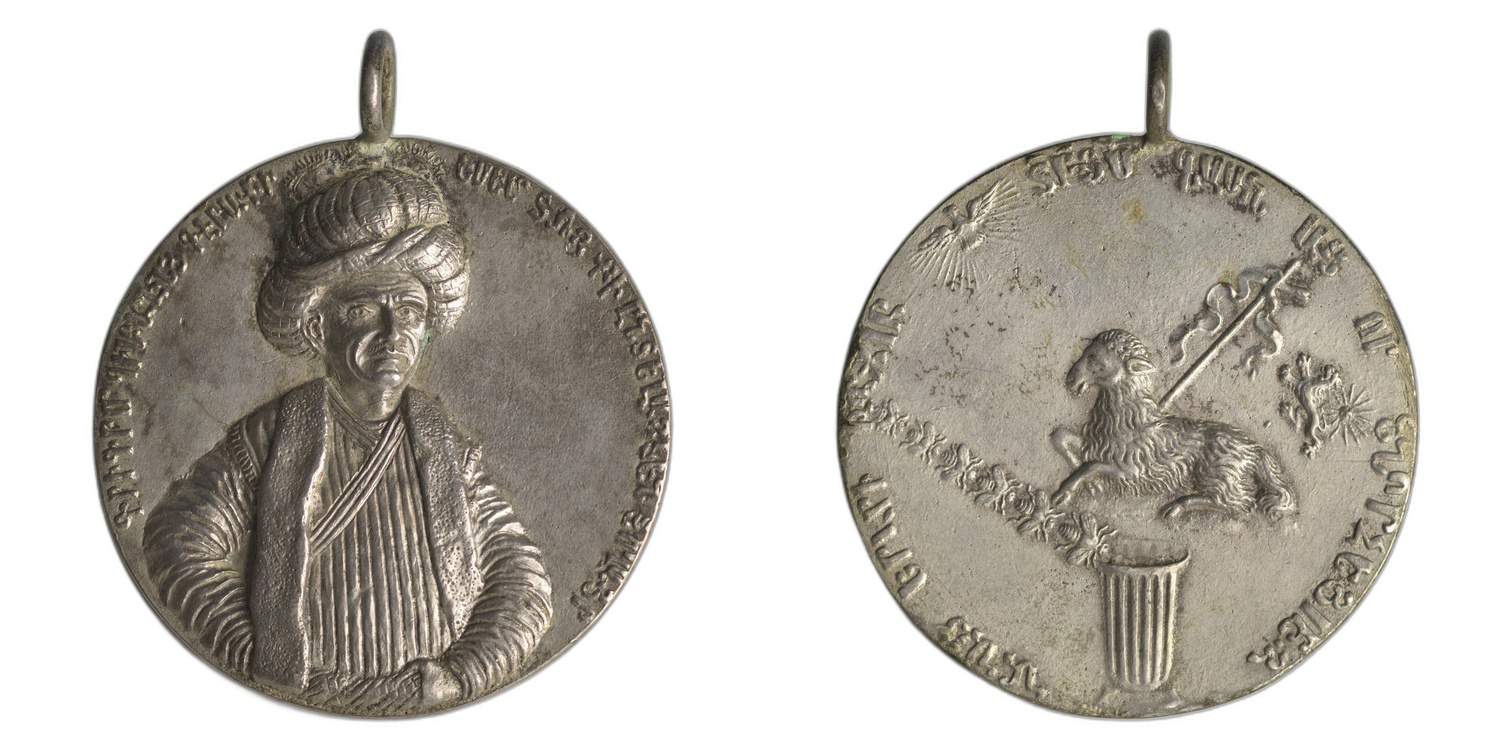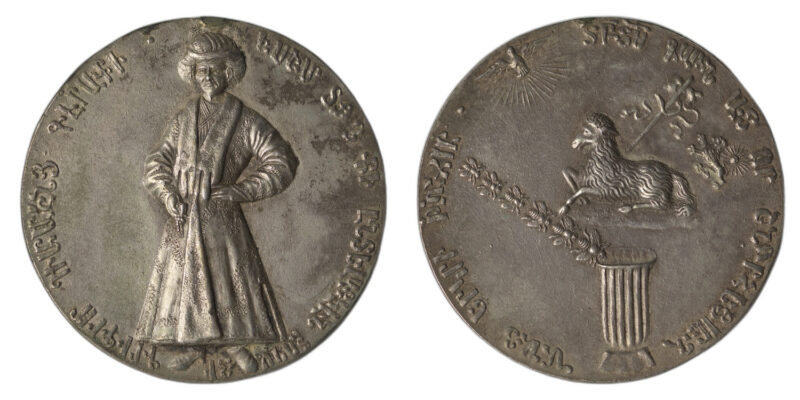Originally by Henry Sarkissian, Revised & Translated by Aram Manasaryan
In the 17th-18th centuries, medals created through private commissions became widely popular in European countries. This custom also penetrated Armenian reality, initially in Armenian diaspora communities and later in Armenia itself.
Medals issued for household, ecclesiastical, and other occasions were worn by women as jewelry, and in some cases, they also served as talismans. The earliest examples of the medals that interest us were created in the second half of the 17th century in Venice or Amsterdam and are associated with the merchants of New Julfa. Only a few examples have survived to this day and are kept in various museums and private collections. This is why they have been scarcely studied.
The medals under consideration were commissioned in 1673 by Grigor Geraki, a representative of one of the well-known families of New Julfa, and they are known in two variations. On the obverse side of one of the medals, Geraki’s bust is depicted up to the waist. He is wearing a loose robe and a turban on his head. At the upper edge of the medal, there is an inscription.

(Գրիգոր, որդի Միրմանենց Գերակի, ես եմ տեառ Հիսուսի հավիտյան ծառան տիրոջ)
(Grigor, son of Mirmanean Geraki, I am the eternal servant of Lord Jesus)
On the reverse side, the Lamb of God is depicted with a military standard, with a lion and a radiant sun engraved on the right side. At the bottom of the medal, a beehive is depicted from which bees are flying in a straight line. Near the edge on the left side, a dove is engraved. The surrounding inscription reads:

(Տեր Հիսուս Գառն Աստծո, որ շնորհեց մանանա երկրին թվին ՌՃԻԲ)
(Lord Jesus, Lamb of God, who bestowed manna upon the earth in the year 1673)
The medal has a loop and a diameter of 70 mm (see Fig. 1)

(Fig. 1) ANRO-1578 Firenze, Museo Nazionale del Bargello, inv. 9130
On the obverse side of the second medal, Grigor Geraki is depicted in full length, wearing a long, loose robe, slightly turned to the left. He holds an abacus in his right hand, with his left hand resting on his waist. The edge inscription on the medal is a repetition of the inscription described earlier. The composition and inscription on the reverse side are also identical to the previous example, with a diameter of 50.5 mm (see Fig. 2).
The medals depicting Grigor Geraki were first discovered by art historian Armenak Sakisian in 1921 in the Medici collection of the Bargello National Museum in Florence. He published these findings in a separate article in 1934 and in the 1940 collection “Pages of Armenian Art.”[i] However, the author did not provide a detailed description of the medals. It is also unknown to us what metal they are engraved on. A. Sakzian is the only specialist who has personally seen these rare medals, but he was not entirely successful in fully reading their inscriptions.
The aforementioned medals were published a second time by L. Khachikyan in 1966 in the article “The Account Book of Merchant Hovhannes Jughaetsi.”[ii] He provided a brief description of the medals and a reading of the inscriptions. L. Khachikyan also did not fully read the inscriptions, as he relied only on copies of photographs.

(Fig. 2) ANRO-1577 Firenze, Museo Nazionale del Bargello, inv. 9129
The inscriptions on the reverse sides of the medals are relatively well-preserved and their reading does not present significant difficulty. These inscriptions are quite worn, some words are given in abbreviations, and there are also errors related to the master’s literacy. This is why we did not have a complete decipherment until now. We have also deciphered the inscriptions with the help of photograph copies and tried to present them as fully as possible. Apparently, the text of the inscriptions on the medals was provided by the commissioner or the text suggested by the master was simply translated into Armenian. Our decipherment reads: “Grigor, son of Mirmanean Geraki, I am the eternal servant of Lord Jesus.”[iii]
The Geraki family was one of the renowned clans of the Armenian diaspora in Venice. In his publication of the list of notable Armenian families in Venice, Ghevond Alishan also mentions the Mirmanean Geraki family from Julfa. Written sources indicate that eight generations of the Geraki family lived in Venice during the 17th-18th centuries.[iv] The medals depict Grigor, the eldest son of Geraki from the Mirmanean family. As mentioned, Grigor Geraki is depicted in traditional Eastern attire, with a turban on his head.[v] This style of clothing was common and acceptable for the inhabitants of New Julfa during that period.[vi]
As mentioned earlier, the images on the reverse sides of the medals are identical. These details were very common in the medals created in private workshops during that period. Symbols like the Lamb of God, the dove, the bee, and others were frequently depicted on medals in European countries during the 17th-18th centuries. Researchers have extensively studied the symbolic representations on these sides of the medals. Specifically, Armenak Sakzian considers the depiction of the beehive and bees as an allegorical expression of work and extensive activity.[vii] L. Khachikyan interprets the beehive as representing the Geraki family’s treasury, while the bees symbolize their numerous hardworking members spread across the world.[viii]
Both hypotheses of the researchers are plausible and do not contradict each other. One thing is undeniable: the artist intended to highlight the diligence of the Geraki family, their expertise passed down through generations, and their tireless activity.
The medal-making master presented the emblem of the Persian state in a somewhat unusual manner. Using almost all the details of the emblem, he depicted the lion not standing on three legs with a scimitar, but walking on two paws to the left, with a radiant sun on its right side. Apparently, the artist created the emblem based on the description provided by the commissioner and, influenced by the heraldic symbols of European countries, presented it in a “creative” manner according to his own conception.
The medals depicting Grigor Geraki are the earliest known commemorative medals with Armenian inscriptions. Unfortunately, with the current available materials, it is impossible to determine the exact location where these rare artifacts were created. It is likely that these medals were made by goldsmiths in Venice or Amsterdam, whose names, as a rule, have not been preserved.
[i] A. Sakisian, “Regarding two Armenian medals from 1670 featuring a merchant from Julfa near Isfahan,” Revue Historique, CLXXIV, 1934; Armenag Sakisian, “Pages of Armenian Art,” Paris, 1940, pp. 125-126
[ii] L. Khachikian, “The ledger of the merchant Hovhannes Joughayetsi.” From the Journal of the Asiatic Society. H.Y, 1966, pp. 154-155
[iii] Undoubtedly, this reading should also not be considered final and must be accepted with some reservations.
[iv] Fr. Ghevond Alishan, “Armenian-Venetian Relations in the 13th-15th and 16th Centuries,” Venice-St. Lazarus, 1896, p. 501
[v] L. Khachikian, cited work, p. 154
[vi] S. V. Ter-Avetisyan, “The City of Julfa,” Tbilisi, 1937, pp. 37-38
[vii] Armenag Sakisian, “Pages of Armenian Art,” Paris, 1940, p. 115
[viii] L. Khachikian, cited work, p. 155
For references, see Sarkissian, Henry V. “Eighteenth Century Armenian Medals and New Julfa / XVIII դարի հայկական մեդալները ու Նոր Ջուղա.” Alik (daily newspaper), no. 217, Oct. 1993, p. pp 4-6.
For an interesting read, you may also check out: Baghdiantz, Ina. The Armenian Merchants of New Julfa: Some Aspects of Their International Trade in the Late Seventeenth Century. Ph.D. Dissertation, Columbia University, 1993. Ann Arbor, MI. Available here
Also: Barsoumian, Hagop Levon. “Debt, Trust, and Reputation in Early Modern Armenian Merchant Networks.” Journal of the Economic and Social History of the Orient 61, no. 3 (2018): 424-450. Available here
